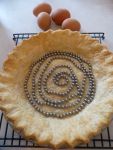Tips & Tricks
Top 4 Tips for Getting Your Pie Crust into the Pie Plate Successfully
- Make a larger batch of dough. Having a generous amount of dough to start with allows you to roll it out plenty big and then trim away the extra instead of stretching and patching to make it fit the plate. My recipe for a generous double 9” crust can be found under the “Pie Crust” section of recipes at www.piepals.com.
- Roll on a smooth, cold surface. This can make all the difference! The pastry will hold together better (and be flakier). Use a chilled rolling surface, such as a plastic one that has icy packets inside (available at cooking stores), a marble stone, or chill your counter by setting a bag of ice on it ahead of time.
- Roll the dough between 2 sheets of plastic wrap. Use 2 sheets each about 15” long on your cold surface. Place the dough between the sheets with a little bit of flour above and below, and roll gently from center to side, center to side, to create your circle. Once in a while, add a little flour as you go. Most likely, when your circle is large enough, a little dough will extend beyond the edges of the plastic wrap. Just loosen the edges with a spatula and add a bit of flour, if necessary, to prevent sticking on the surface or your rolling pin.
- Get it in the pie plate. If you’ve rolled out the dough between 2 sheets of plastic wrap, then it’s easy. Simply peel off the top layer of plastic and loosen with a spatula any dough that extends beyond the sides of the bottom sheet of plastic. Pull your pie plate close to where you’re working. Slip one hand (palm up) under the plastic and center it under your dough. Gently center your other hand (palm down) over the dough. Then, with a confidence you didn’t know you had, simply flip the whole thing over into the center of the pie plate. Peel off the remaining plastic wrap and move the dough a little this way or that if needed to get it centered. Gently lift the outside edges of the dough to let it ease down into the bottom of the pie plate.
Another way: Roll the dough onto the rolling pin for transfer. Place the rolling pin near the far edge of the dough, holding it above by ½ inch. Using your spatula, start the dough rolling up onto the pin, then continue winding the dough up onto the rolling pin as it comes towards you. When you’ve got it off the rolling surface, transfer it to the pie plate, setting the edge of dough about 1” out from the edge of the pie plate. Unroll the dough, easing it gently into the pie plate…and voila! You did it!
Pie dough tends to crack and tear, so don’t worry about that. Just pinch it together and carry on!
© Pie Pals, LLC, 2018, Rebecca Jo Dakota
Top 8 Tricks for a Perfect Prebaked Pie Crust
- Start with chilled dough. After making the dough, make sure to chill it 20-30 minutes before you start to roll it out.
- Roll from the center out. (Just like in life.) This will keep the dough from becoming tough and shrinking when you bake it.
- Make a “pinched” flute design and pull the “tip” of the pinch just under the outside edge of the pie plate. This should be a subtle wrap of the dough over the edge of the plate – enough to hold it in place as it bakes, but not so much as to make it hard to cut and serve the edge of the crust later.
- Chill the dough in the pie plate before baking, at least another 15 minutes. This gives the gluten a chance to relax, which reduces shrinking.
- Be sure to use a fork and prick the entire surface, bottom and sides, of the crust before baking. Prick about 1” apart. This will prevent it from puffing up during baking.
- Use pie weights. These are designed to hold the bottom of the crust down, again to prevent the puffing up that can happen when you’ve made a delightfully flaky crust. Use a pie weight chain, available at places like Bed, Bath & Beyond. See below for what it looks like.

- Check the crust after the first 5 to 7 minutes of baking. If the crust “puffs up” during baking, gently poke any such places with a fork. They will settle down.
- Fully bake the crust! Nothing is worse than a doughy crust. Make sure it’s truly golden brown. Using a glass pie plate is preferable for this reason, so that you can check the bottom, too.
© Pie Pals, LLC, 2018, Rebecca Jo Dakota